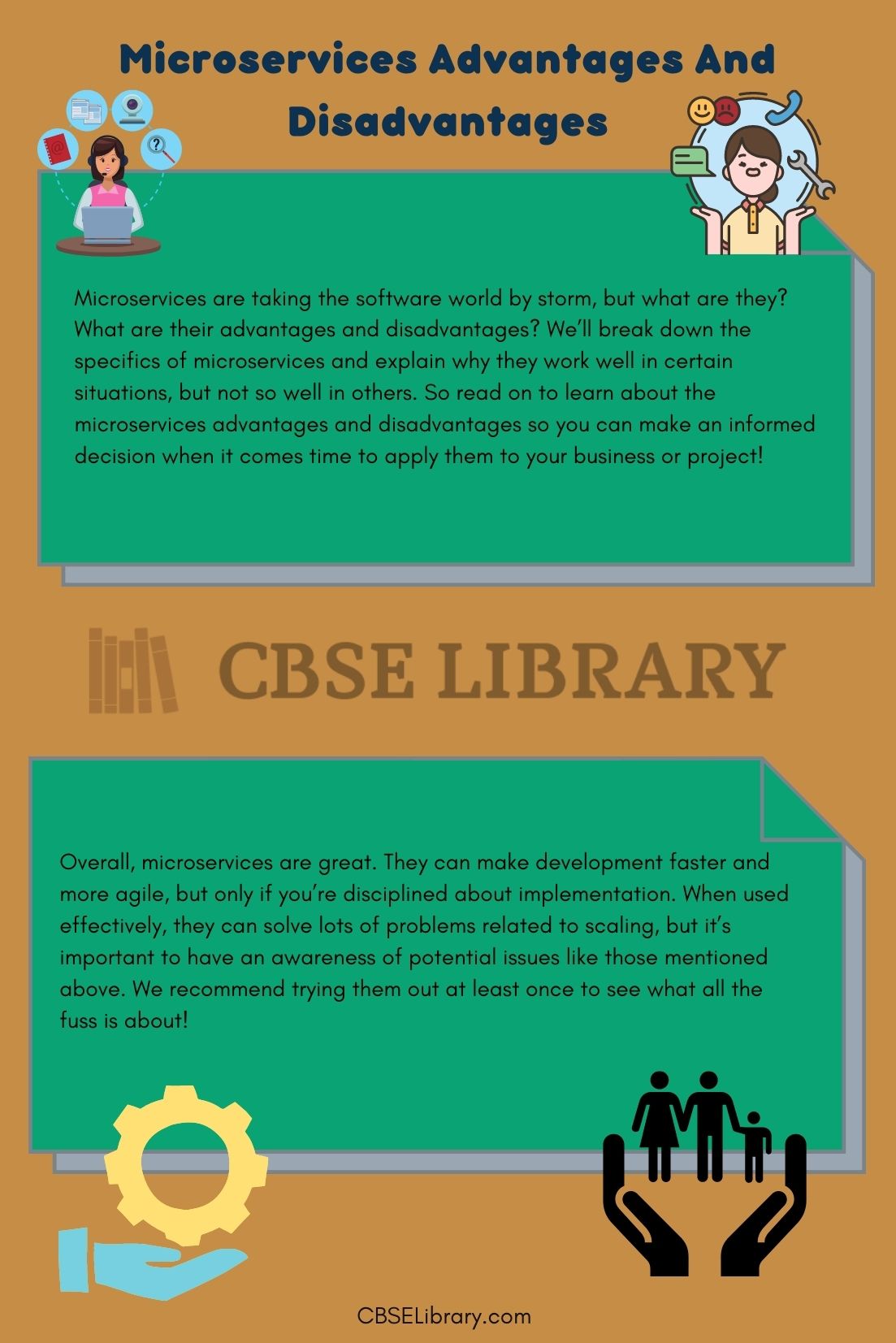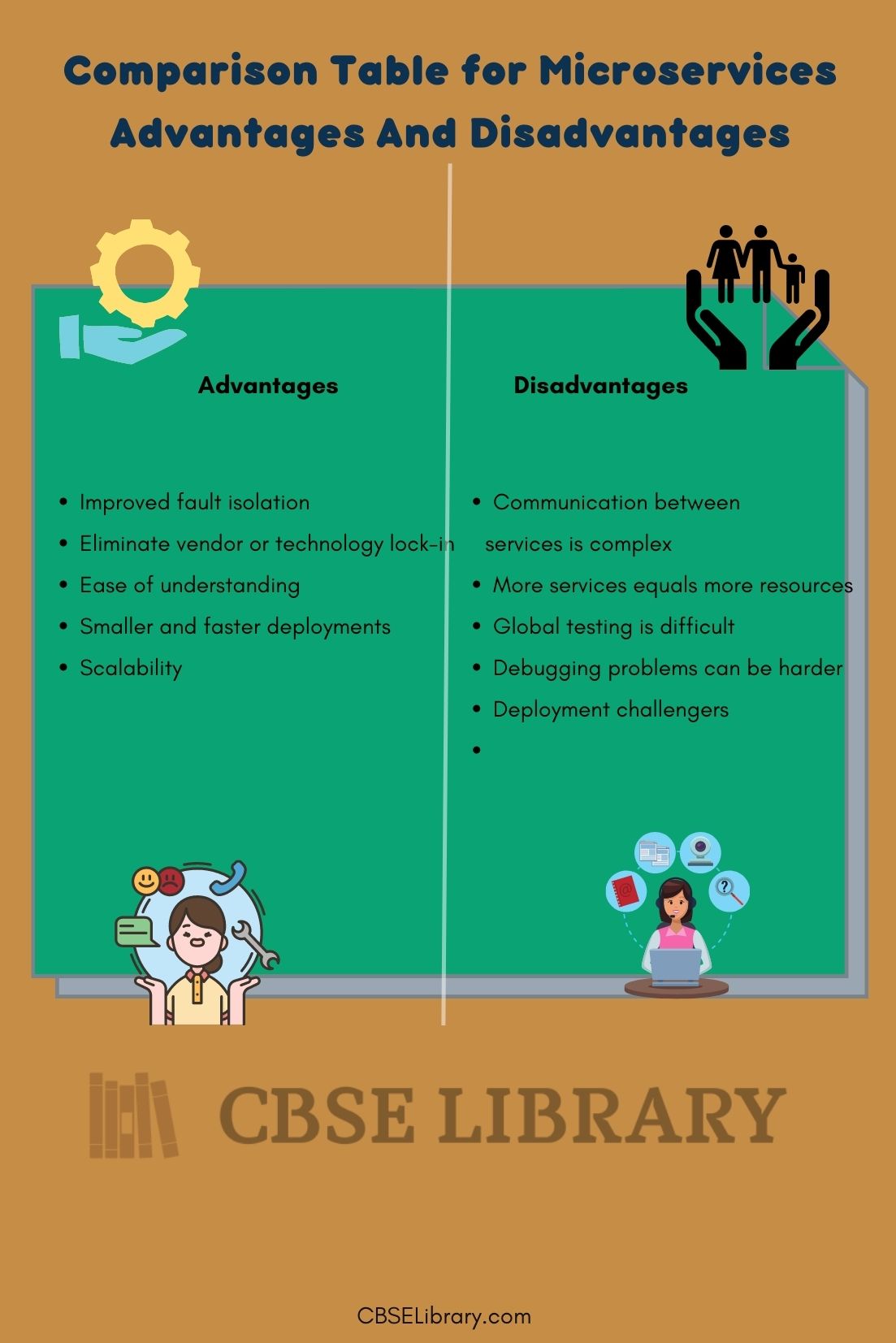Microservices Advantages And Disadvantages: Microservices are taking the software world by storm, but what are they? What are their advantages and disadvantages? We’ll break down the specifics of microservices and explain why they work well in certain situations, but not so well in others. So read on to learn about the microservices advantages and disadvantages so you can make an informed decision when it comes time to apply them to your business or project!
Students can also find more Advantages and Disadvantages articles on events, persons, sports, technology, and many more.
What are Microservices?
Microservices are small, single-purpose applications that work together to create a platform. A platform. Not a product. In fact, in most cases they’re not even called products or applications—they usually don’t have names at all!
- Each microservice is small enough to be its own thing; but as a group, these services make up your whole application or platform.
- A single microservice can be built to serve a single purpose. For example, one service could handle all user registrations, while another handles just password resets. It’s important to note that micro does not mean small; in fact, each microservice is usually quite large—just not as large as your entire application or platform.
- Each microservice has its database, along with its logic and rules for how it interacts with other services. The only way these services communicate with each other is through well-defined APIs—meaning you never have to worry about a bug in one service breaking another.
- Advantages of Microservices
- Disadvantages of Microservices
- Comparison Table for Microservices Advantages And Disadvantages
- FAQ’s on Microservices Advantages And Disadvantages
- Conclusion on Microservices Advantages And Disadvantages
Advantages of Microservices
There are a lot of advantages to using microservices. First, microservices allow companies to build and deploy software rapidly. This is mainly because it’s easy to update individual services when updates need to be made; there is less risk involved since you aren’t changing any other part of your application at that time. Additionally, using microservices allows for developers to be able to focus on one service as opposed to focusing on an entire app.
Improved fault isolation: When using microservices, if a single service fails, it won’t affect any other services. This is because each service runs in its process with its own memory space. This makes debugging easier, as you can pinpoint where exactly a problem lies.
Eliminate vendor or technology lock-in: When using microservices, you can switch out one service for another. For example, if you are currently using a NoSQL database like MongoDB, but want to use a relational database like MySQL instead, you can easily do so without affecting any other services. This is because each service runs in its process with its own memory space.
Ease of understanding: When using microservices, each service is small enough that it’s easy to understand. This makes it easier for developers to understand what they are working on and make changes as needed.
Smaller and faster deployments: When using microservices, you can deploy each service separately. This means that you can make changes to one service without having to redeploy an entire application. Additionally, each service will take less time to deploy than it would if it were a part of a larger application.
Scalability: When using microservices, you can scale each service separately. This means that if you need to add more resources to a specific service, you can do so without affecting any other services. Additionally, when using microservices, it’s easier to make sure that your application is scalable. This is because each service runs in its process with its own memory space.

Disadvantages of Microservices
How many services do you need? Communication between microservices is slower. Each microservice is independently deployable, but coordinating many can be challenging. Adding new features to an existing service affects all users who interact with it. Managing load across a large set of services is more complex than managing the load on a single application server. Reliability concerns must be managed at each service layer instead of being managed at a higher level.
Communication between services is complex: In a monolithic application, all components are within a single process. This means that any component can interact with any other component in that process. In a microservice architecture, each service is deployed as its separate process, which means that components must communicate with each other over some form of network. There are many ways to accomplish communication over a network, but they all have their advantages and disadvantages.
More services equals more resources: Each microservice has its database, web server, application server, and so on. This means that as you add more microservices to your architecture, you are adding more total resources to your architecture. These additional resources can increase your costs as well as create performance bottlenecks.
Global testing is difficult: When you have a monolithic application, you can test it in its entirety. However, when you have many microservices, it becomes much more difficult to test all possible combinations of interactions between your services. Most organizations don’t even try to test every possible combination; instead, they use some form of global load-testing tool that simulates user interaction with their entire system.
Debugging problems can be harder: When you have a monolithic application, it’s easy to figure out where an error is coming from. You just look at your logs and see what component logged that error. In a microservice architecture, there are many more places where errors could originate.
Deployment challengers: When you have a monolithic application, you can deploy it as a single unit. However, when you have many microservices, each service must be deployed individually. This means that if one service is having problems, it’s more difficult to isolate which service is causing those problems.
Comparison Table for Microservices Advantages And Disadvantages
| Advantages | Disadvantages |
| Improved fault isolation | Communication between services is complex |
| Eliminate vendor or technology lock-in | More services equal more resources |
| Ease of understanding | Global testing is difficult |
| Smaller and faster deployments | Debugging problems can be harder |
| Scalability | Deployment challenges |

FAQ’s on Microservices Advantages And Disadvantages
Question 1.
What are microservices?
Answer:
The term microservice was coined by James Lewis in a 2011 paper on building large-scale service-oriented systems. The idea is to break down an application into smaller, discrete services that can be independently deployed, versioned, scaled, and updated—in other words, it’s an approach to developing applications that are more flexible than traditional monolithic software architectures.
Question 2.
What are examples of microservices?
Answer:
The canonical example is a microblogging platform like Twitter, which has separate services for things like user accounts, photo storage, messaging, and more. The advantage here is that each service can be scaled independently—if you need to add users to your social network, you don’t have to worry about adding new capacity to your messaging service at the same time (and vice versa). This kind of modularity also makes it easier to update individual components without having to update everything at once.
Question 3.
Is an API a microservice?
Answer:
Not necessarily, but it can be. If you have a set of web services that are part of a single application, you could consider them to be microservices if they’re designed to be independently scalable or replaceable—for example, each service might perform one specific function like user authentication or data storage, which could then be swapped out with another service if necessary.
Question 4.
Is Docker a microservices?
Answer:
Not necessarily, but it can be. Docker allows you to package up applications into containers that can run on any machine with Docker installed—it’s not tied to a specific infrastructure or platform, which makes it more portable than traditional virtual machines.
Conclusion on Microservices Advantages And Disadvantages
Overall, microservices are great. They can make development faster and more agile, but only if you’re disciplined about implementation. When used effectively, they can solve lots of problems related to scaling, but it’s important to have an awareness of potential issues like those mentioned above. We recommend trying them out at least once to see what all the fuss is about!
